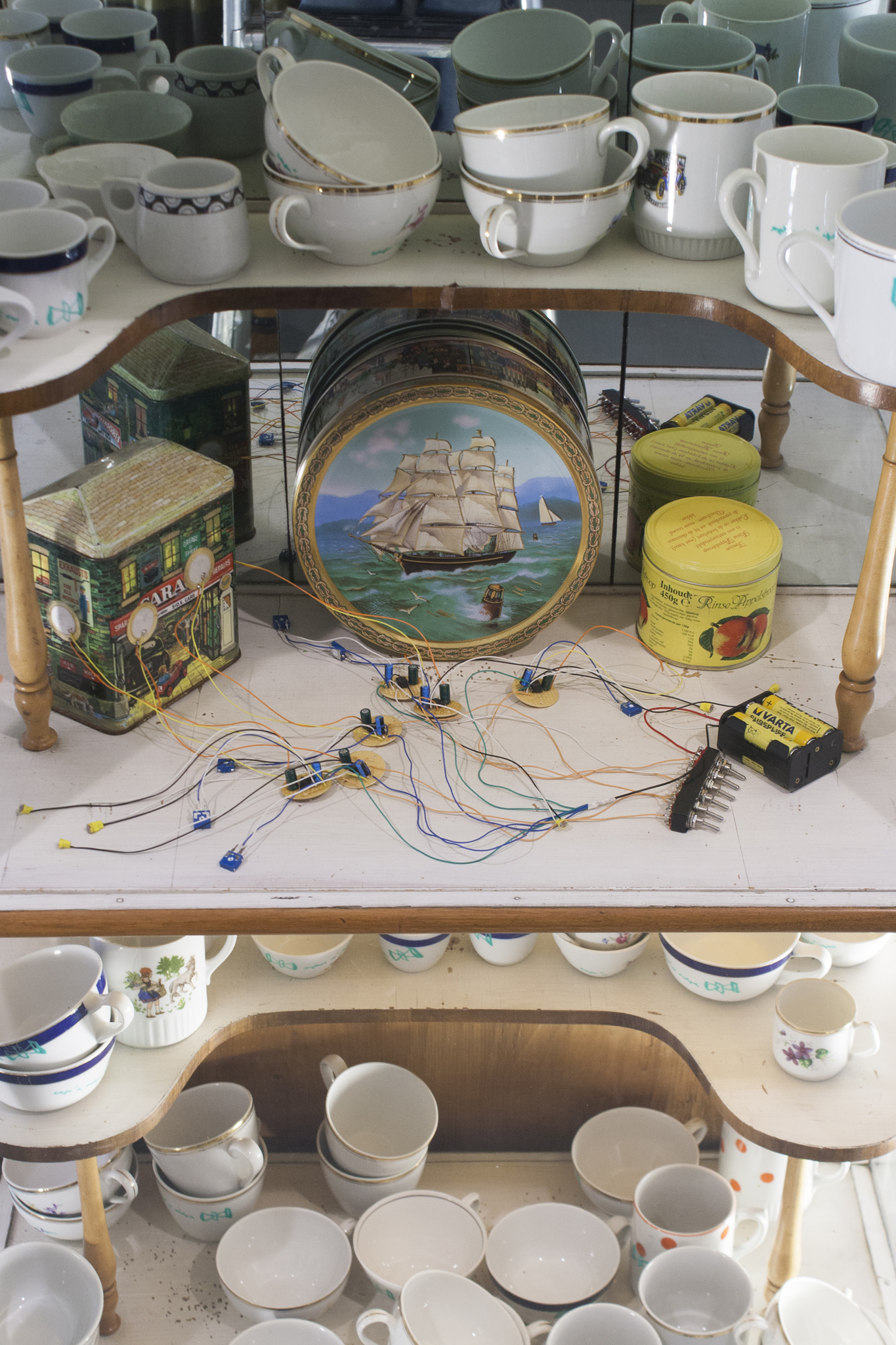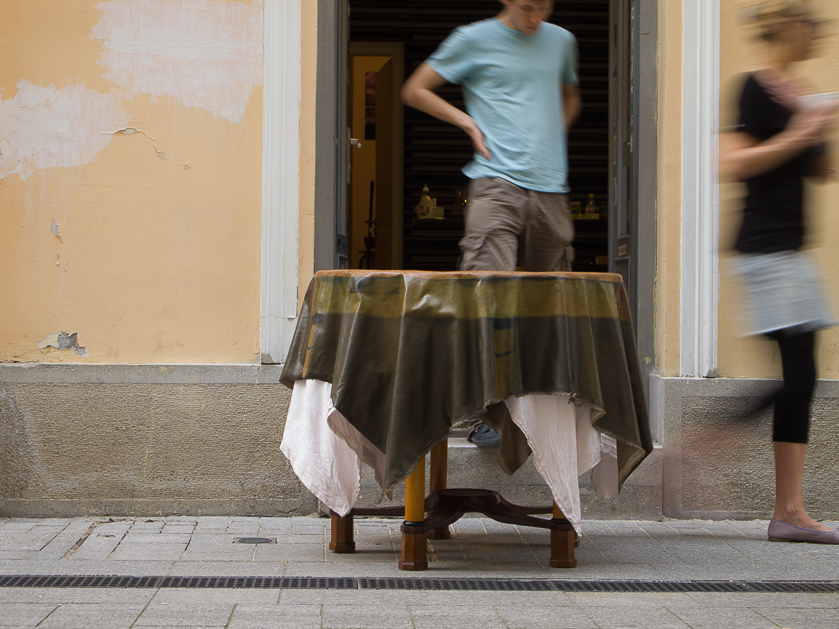Balkon 2013_7, 8
Mónika Zsikla
Images from the Parlour
CAFÉ À VIDYA
Exhibition of Eszter Szüts, Patrik Iván Kund
Build-up: Sander Bremer, Audio: Lepsényi Imre, Lights: Gungl Tibor
• Labor, Budapest
• 20-26th May 2013.
“I have often shewed this kind of spectacle to my friends, who much admired it, and took pleasure
to see such a deceit; and I could hardly by natural reasons, and reasons from the Opticks remove
them from their opinion, when I had discovered the secret.”
Giovanni Battista della Porta: Magia naturalis sive de miraculis rerum naturalium,
1558. B 17., Ch. 6.
Three spaces — Three experiences, one community. Although there was a logical order of walking the spaces, it was also the best decision in retrospect to begin at the “back”, i.e. from the furthest corner of the exhibition space of the Labor, in the darkness behind the wall built with Finnish eminence out of rough/unhewn lattice, where I could silently wonder about the possible implications of the coffee brewing artist I saw outside, the chirping cookie box and the varnished dining table. The surreal ingredients have delegated the task in the darkness to deal with the fact that the noises seeping in from outside, the smell of fresh coffee, and the milieu of the bourgeois parlour on the other side of the lattice wall do not function according to the choreography of the white cube, oddly enough. It seemed an evident solution that I as a visitor have to “function” differently as well, namely that I am to sit on the ground in an unlit space in the company of a rug that slid over from the parlour while thing about the failure of my triedout habits of perception. The hermeneutics of the word VIDYA in the title of the exhibition was what made me move on from my reflections. I have found out from Eszte Szüts that the name in Sanskrit is an attribute denoting the clearest inner vision in Eastern culture to this day. From a semantics perspective this I had to reflect upon is total darkness. I took over the lightless space around me with such pieces of thoughts, but I also remembered the slightly embarrassing moments of childhood visits at friendly families when climbing under tables with tablecloths hanging to the ground I have followed emotions like the above. A distress also came upon me that my inner visions are projected to the walls and in the parlour Freud’s sofa awaits, however the dream interpretation was held off as soon the artists woke me with some coffee.
Instead of the screen of fantasies the silhouettes of the parlour’s china cabinet and the green trees in the street were the ones to loom in the dark as a swiftly arriving fata morgana. The phenomenon has put my personal utopia to an end, but I was just as unprepared as the guests of the Japanese teahouse when the the image of the sacred mountain on the rice-paper door appeared in the print series of Hokusai.1 On the print the frightened figures were comforted by the servant by showing them the small hole on the window that had induced the optical phenomenon. On the upside-down image of my private camera obscure soon Eszter appeared, who was repacking the cleaned coffee cups on the shelves of the China cabinet, while on the street two hounds walking with their owner seemed to be sniffing at the parlour’s reflector lights. In the shadow play the spaces of the street outside and the parlour inside were indistinguishably washed
together, and for all this the Biedermeier furniture - the emblems of bourgeois culture - served as
an inside-out set. The time limit of these silent movie shots were only defined by the positioning of the space. For this phenomenon to occur, the concentration of natural sunlight is the most intensive during the afternoon hours in this narrow inner city street. Due to its urbanistic characteristics the intended vision is most defined in this short interval, thus the visitor can only experience vidya if s/he was present at the suitable time of day. All of this is linked to the theses by Buirraud in Relational aesthetics.2 On the one hand from the point of view of the relationship between revelation and reality, namely “representation is only a moment of reality: every image is a moment, the same as any point in space is just the memory of X time and the reflection of Y space.”3 The other thesis is about the presence of the recipient/beholder, who “has to go to a place to experience a work of art which in turn only exists as work of art through this experience.”4 The
vidya experience of the camera obscura built at the Labor had to meet the same criteria, by specifying space and time it generated illusive images for the beholder who was present at the right time. A third principle of the theoretician also held its ground in the intimate milieu of the rightly placed object of the parlour once stepping out of the chamber, that claims “the work of art can also serve as an machinery producing relationships, part of which a certain degree of chance, just as a machinery that creates and coordinates individual or collective encounters.”5 We have seen earlier that the factor of chance was coded in the well or badly timed arrival, the prefix of the title of the exhibition was from the perspective of the recipient was a clear invitation to a cup of coffee consumed together. For the coffee each visitor could choose an individual cup/mug from the China cabinet and coming before the table where the artist prepares the coffee.
While the preparation of the beverage took place it occurred to me looking back from the front that the varnished table, was not at all what it seems, from its top a canvas was hanging down as a tablecloth, on it the varnish was painted on photorealistically. Another flick toward the bourgeois culture as well as to contemporary painting, which became a tablecloth. The dialogue that started out from next to the steaming drink has imperceptibly transitioned me through to the “active” phase of the exhibit where we came together as a team with the artist and the other visitors in the representative space furnished to be communal. They closed the door of the dark room with cups in their hands... „Everyone sees something different inside”. I only noticed the hand painted pictogram of flipped mirroring when I set off to leave...
1 Fushi-ana no Fuji/ The revrsed (camera obscura) imsge of Mt. Fuji in a tea house, Katsushika Hokusai – Fugaku Hyakkei: 100 Views of Mt. Fuji, 1835 k.
2 Nicolas Bourriaud: Relational Asthetics, Elmegyakorlatok- Műcsarnok- könyvek 01. Budapest, 2007
3 ibid. p. 66.
4 ibid. p. 24.
5 ibid. p. 25.
Balkon 2013_7, 8
Zsikla Mónika
Képek a szalonból
CAFÉ À VIDYA
Szüts Eszter, Kund Iván Patrik kiállítása
Konstrukció: Sander Bremer, hang: Lepsényi Imre, fény: Gungl Tibor
• Labor, Budapest
• 2013. május 20–26.
„És jó barátainknak sokszor tartottunk ámulatra ilyen színjátékot, és úgy belebűvölődtek,
hogy a látástudomány természetes indokaival és érveivel azután is nehezükre esett kialakított véleményüktől eltérítenünk őket, miután elárultuk nekik a fortélyt.”
Giovanni Battista della Porta: Magia naturalis sive de miraculis rerum naturalium,
1558. 17. könyv, 6. fejezet.
Három tér — három élmény, egy közösség. Bár a terek bejárásának volt logikus sorrendje, utólag is a legjobb döntésnek bizonyult „hátul” kezdeni, vagyis a Labor kiállítóterének legtávolabbi szegletében, a csiszolatlan falécekből finn nagyvonalúsággal megépített fal mögötti sötétben, ahol csendben elmerenghettem a kint látott kávét főző művész, a ciripelő kekszesdoboz és a politúrozott ebédlőasztal közötti lehetséges összefüggéseken. A szürreális hozzávalók ugyanis azt a feladatot delegálták, hogy a sötétben számoljak el azzal a ténnyel, hogy a kintről beszűrődő zajok, a friss kávé illata és a lécfal másik oldalán berendezett polgári szalon miliője zavart keltően nem a white cube koreográfia szerint működik. Evidens válasznak tűnt, hogy akkor látogatóként is másként kell működnöm, jelesül egy megvilágítatlan térben, a földön ülve a szalonból átcsúszott nagy szőnyeg társaságában elmélkedjek bevett percepciós szokásaim kudarcán. A számvetésen
a kiállítás címében szereplő VIDYA szó hermeneutikája lendített tovább. A szanszkrit név a keleti kultúrában ma is a legtisztább, belső látásra utaló szakrális jelző, tudtam meg Szüts Esztertől. A jelentéstan valóságától talán az sem állt távol, hogy ezen a vaksötétben kellett elgondolkodnom. Többnyire ehhez hasonló foszlányokkal laktam be magam körül a fény nélküli teret, de eszembe jutott még a gyermekkori vendégségek kínos pillanata is, amikor az asztalról lelógó, földig érő terítő alá bebújva a fentiekhez hasonló érzéseket kergettem. Valamint rám tört a szorongás is, hogy belső vízióim projektálódik a falakon, és kint a szalonban majd Freud kanapéja vár, de az álomfejtés ezúttal elmarad, mert a művészek hamarosan kávéval ébresztenek. A képzelgések vetítővászna helyett azonban a szalon vitrines szekrényének és az utca zöldellő fáinak sziluettjei derengtek fel a sötétben, mint egy hirtelen érkező fata morgana. A jelenség ugyan véget vetett az individuális utópiámnak, de legalább annyira felkészületlenül ért, mint Hokusai metszetsorozatán1 a japán teaház vendégeit a rizspapír tolóajtón megjelenő szent hegy képmása. A metszeten a megrémült alakokat a szolgáló az ablaktáblán nyílt kis lyuk látványával nyugtatta, amely a létrejött optikai jelenséget gerjesztette. Privát camera obscurám fordított képén hamarosan feltűnt Eszter, aki az elmosogatott kávéscsészéket a vitrines szekrénybe rakosgatta, az utcán gazdájával sétáló két vizsla pedig látszólag a szalon derítő reflektorának fényét szimatolta. Az árnyjátékban szétválaszthatatlanul mosódtak egybe az utca külső és a szalon belső terei, és mindehhez a polgári kultúra védjegyének számító biedermeier bútorok magukból kifordulva biztosították a díszletet. A snittekből összeállt némafilm hosszúságának a tér tájolása szabott csak némileg határt. A jelenség létrejöttéhez szükséges természetes napfény koncentrációja ugyanis a délutáni órákban
a legintenzívebb a szűk belvárosi utcában. Az urbanisztikai adottságnak köszönhetően ezért a szándékolt látvány ebben a rövid időintervallumban a leghatározottabb, így a látogató akkor részesülhetett vidya-ban, ha pont a megfelelő pillanatban volt jelen.
Mindez két ponton kapcsolódik Bourriaud-nak a Relációesztétikában2 megfogalmazott téziseihez. Egyrészt a megmutatkozás és a valóság kapcsolata szempontjából, miszerint „a reprezentáció a valóságnak csupán egy pillanata: minden kép egy-egy pillanat, ugyanúgy, ahogy a tér bármelyik pontja X idő emléke és Y tér tükröződése”.3 A másik tétel a befogadó jelenlétére vonatkozik, akinek „el kell mennie valahová, hogy megtapasztaljon
egy művet, az pedig mint műalkotás kizárólag ennek a megtapasztalásnak köszönhetően létezik”.4 A Laborban megépített camera obscura vidya élménye is ezen kritériumok alapján teljesült, hely és idő specifikumával illékony képeket generált az épp jó időben jelenlévő befogadó számára. A kamrából kilépve a helyreállt szalontárgyak bensőséges közegében a teoretikus egy harmadik tana is aktuálissá vált, amely szerint a „műalkotás működhet úgy is, mint egy kapcsolatokat generáló berendezés, melynek részét képezi bizonyos fokú véletlen is, mint egy olyan gépezet, mely egyéni vagy kollektív találkozásokat idéz elő és irányít”.5 A korábbiakban láttuk, hogy a véletlen faktor bele volt kódolva a látogató érkezésének jó vagy rossz időzítésébe, a kiállítás címének előtagja pedig a befogadói olvasatban egyértelmű felhívás volt egy közösen elfogyasztott kávéra. A kávéhoz minden látogató egyedi bögrét is választhatott magának a vitrinből, odajárulva azzal a kávét főző művész asztalához. Miközben készült a fekete, az előtérből visszanézve az is feltűnt, hogy a politúros asztal nem is önmagában politúros, hanem a lapjáról terítőként lelógó festővászon maga volt a fotórealisztikusan megfestett politúr. Még egy fricska a polgári kultúrának, és a kortárs festménynek is, amiből egyszer csak terítő lett.
A gőzölgő fekete mellett kezdődő dialógus észrevétlenül vezetett át a kiállítás „aktív” részébe, ahol a művésszel, és az újonnan érkező látogatókkal a közösséginek berendezett reprezentatív térben automatikusan egy csapattá kovácsolódtunk. Ők már csészékkel a kezükben zárták magukra a sötétkamra ajtaját... „Mindenki mást lát odabent”. Induláskor vettem észre a porcelán bögre oldalán a kézzel ráfestett fordított tükröződés piktogramot...
1 Fushi-ana no Fuji/ A Fuji hegy fordított állású (camera obscura) képe egy teaházban, Katsushika Hokusai – Fugaku
Hyakkei: A Fuji 100 látképe című művéből, 1835 k.
2 Nicolas Bourriaud: Relációesztétika, Elmegyakorlatok- Műcsarnok- könyvek 01. Budapest, 2007
3 u.o. 66.o.
4 u.o. 24.o.
5 u.o. 25.o.























